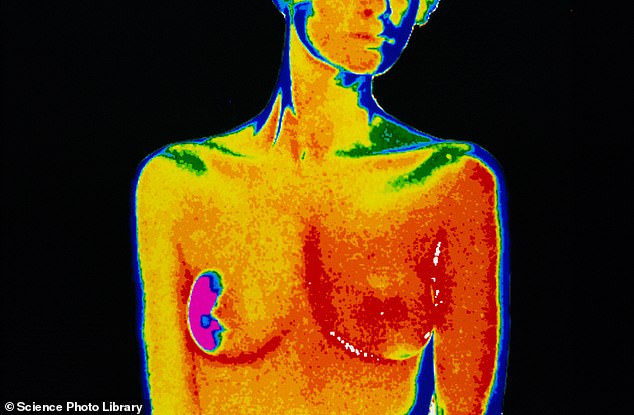After a double mastectomy, followed by chemotherapy, Hannah Gardner was confident she had beaten breast cancer. Even when cancer was detected in his chest wall four years later, he wasn’t too worried.
“It was an unmistakable pea-sized lump in the chest that I had reconstructed,” says Hannah, 38, a clinical trials director who lives in Twickenham, and a scan confirmed the worst.
“I was treated at the Royal Marsden Hospital (in London) and after surgery to remove more tissue, chemotherapy and radiotherapy, I was assured that I had a good chance of living cancer-free.”
Hannah, who was 26 when she was first diagnosed with the disease in 2013, felt so calm that she and her husband Peter, a firefighter, decided to start a family. In July 2020, a daughter, Lilah, was born.
So Hannah was shocked when a routine scan a few months later, in November 2020, revealed cancer cells in the lymph nodes under her arm.
“The only sign was a strange throbbing sensation in my armpit that had started a few weeks earlier,” he says.
After radiation therapy, Hannah once again dared to hope for the best. But two years later, a routine scan revealed that the cancer had returned. This time it had spread to his liver.
“The oncologist made it very clear: it was a secondary cancer and there was no cure,” he says. “It was my worst nightmare.”
After a double mastectomy, followed by chemotherapy, Hannah Gardner was confident she had beaten breast cancer.
Hannah is one of an estimated 57,000 women in the UK living with secondary breast cancer, according to a 2021 NHS admissions study, a figure that has been increasing year on year since 2018. Between 10 and 40 per cent of UK patients diagnosed with primary breast cancer go on to develop secondary breast cancer.
The good news is that while secondary breast cancer remains incurable, treatments have improved dramatically.
“Secondary breast cancer is no longer a death sentence – it is very treatable,” explains Russell Burcombe, clinical oncologist at Maidstone and Tunbridge Wells NHS Trust.
«For decades, the overall survival rate remained between two and three years. But there have been such exciting advances in treatment that the average life expectancy is now five years, and many will live longer than that.’
On average, 67 percent of women live one year after a secondary breast cancer diagnosis; 26 percent live five years and 11 percent live at least ten years.
“One of the most important things scientists are working on is making breast cancer a chronic disease that patients live with, not die from,” adds Dr. Burcombe.
‘The biggest change has been the use of drugs called CDK4/6 inhibitors, tablets that improve the effectiveness of hormone therapy, which works to stop or slow the growth of cancer cells. We now have patients taking a hormonal tablet with one of these medications for ten years or more.
‘Then we have immunotherapy, which uses the immune system to fight cancer and is usually administered by intravenous injection. It is particularly successful in treating patients with aggressive triple-negative breast cancer, who fared particularly poorly if the cancer recurred.’
Hannah is now in a clinical trial involving immunotherapy. “I’ll be in treatment for the rest of my life,” he says. ‘It’s not a walk in the park, but at least it’s giving me time.
‘No one wants to think about cancer coming back. I certainly didn’t. But there’s no point in hiding your head in the sand.
“The sooner you seek a diagnosis and begin treatment, the better your chances.”

The most common site of secondary breast cancer is the bone, followed by the lungs, liver, skin, and brain.

Hannah is one of an estimated 57,000 women in the UK living with secondary breast cancer, according to a 2021 NHS admissions study, a figure that has been increasing year on year since 2018.
Looking back, Natalie Gibbs, 48, knows she should have reported her symptoms sooner. The Pilates teacher and energetic mother-of-two considered herself too fit and healthy to bother doctors after falling and breaking a rib. He had also been suffering from back pain for several months, which he attributed to a chest infection.
It wasn’t until January 2020, two months after the fall, that Natalie decided she could no longer ignore the wrinkled skin on both breasts and made an appointment at the breast care center at KIMS, a private hospital in Maidstone, Kent.
Scans and biopsies revealed secondary breast cancer, which had spread to her bones and ovaries. I had no idea broken rib was a symptom.
In fact, when breast cancer spreads outside the breast through the lymphatic or blood system, it most commonly reaches the bones first, making them brittle and prone to breaking.
“I was in total shock,” says Natalie, who lives in Canterbury, Kent, with her husband Alfie, 55, a surveyor, and children George, 19, and Olivia, 16.
“I had noticed the changes in my breasts for many months, but I had buried my head in the sand because I was too afraid to recognize that it could be cancer,” she says. “Finding out that it had already spread was devastating.”
While most women know the symptoms of breast cancer, which include lumps and wrinkles on the skin, alarmingly few know the signs of secondary or stage 4 breast cancer. Even fewer know the encouraging news that it is now very tractable.
The most common site of secondary breast cancer is the bone, followed by the lungs, liver, skin, and brain.
However, a survey conducted by GenesisCare, a provider specializing in cancer care, found that 72 percent of women who had previously been diagnosed with cancer did not know where in the body it was likely to appear.
After a six-month chemotherapy program, as well as bone-strengthening medications, Natalie is back to being active. “I thought it was a death sentence, but the drugs have kept the cancer at bay for four years,” he says.
‘Sadly, in July 2023 I began to suffer disabling headaches and scans showed the cancer had spread to my brain.
‘I had radiotherapy to my brain and now take immunotherapy tablets every day and chemotherapy tablets 14 out of 21 days of each month.
‘For the sake of my family, I cannot allow cancer to dominate my life. I believe in moving forward. I have a lot to do, like getting George ready for college last year and Olivia for boarding school.
A worrying number of women would also not think to mention their history of breast cancer to their GP when faced with new, seemingly unrelated symptoms.
According to research from GenesisCare, 80 percent of women with a previous diagnosis would not link excessive tiredness, nausea or loss of appetite to cancer; However, all of these symptoms may be related to secondary breast cancer in the liver.
And 78 percent would not mention their history if they had a cough or difficulty breathing, even though both are symptoms of secondary breast cancer in the lung.
As expected, the highest risk of recurrence occurs in the first few years after treatment. Risk factors include the type of breast cancer, the stage at which it was diagnosed, the size of the tumor, how many lymph nodes, if any, were affected, and factors such as obesity and alcohol consumption.
“No tool can guarantee that the cancer will not come back,” says Nicola Roche, a breast surgeon at the Royal Marsden.
‘But it is important to choose a healthy lifestyle. There is a link between high levels of estrogen in the blood and the recurrence of breast cancer. A diet high in fat and calories can increase circulating estrogens.’
Dr Burcombe adds: ‘I understand that patients want to forget they had cancer, but I always tell them that even if they were diagnosed 15 years ago, they are not out of the woods.
“Most GPs will be alert for a recurrence, but if you have a symptom such as a cough or new, prolonged and unusual pain, you should always consult your GP and point out your cancer history, even if you think It’s not related.” .’
Hannah and Natalie are participating in a GenesisCare campaign to raise awareness about secondary breast cancer. For more information on symptoms to look out for, go to genesiscare.com/uk/second-chance.


